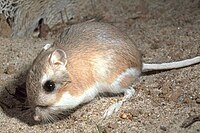
Photo from wikipedia
Resource partitioning promotes coexistence among guild members, and carnivores reduce interference competition through behavioural mechanisms that promote spatio-temporal separation. We analyzed sympatric lion and spotted hyena movements and activity patterns… Click to show full abstract
Resource partitioning promotes coexistence among guild members, and carnivores reduce interference competition through behavioural mechanisms that promote spatio-temporal separation. We analyzed sympatric lion and spotted hyena movements and activity patterns to ascertain the mechanisms facilitating their coexistence within semi-arid and wetland ecosystems. We identified recurrent high-use (revisitation) and extended stay (duration) areas within home ranges, and correlated environmental variables with movement-derived measures of inter- and intraspecific interactions. Spatial overlaps among lions and hyenas occurred at edges of home ranges, around water-points, along pathways between patches of high-use areas, and expanded during the wet season. Lions shared more of their home ranges with spotted hyenas in arid ecosystems, but shared more of their ranges with conspecifics in mesic environments. Despite shared space use, we found evidence for subtle temporal differences in the nocturnal movement and activity patterns between the two predators, suggesting a fine localized-scale avoidance strategy. Revisitation frequency and duration within home ranges were influenced by interspecific interactions, subsequent to land cover categories and diel cycles. Intraspecific interactions were also important for lions and, for hyenas, moon illumination and ungulates attracted to former anthrax carcass sites in Etosha, with distance to water in Chobe/Linyanti. Recursion and duration according to locales of competitor probabilities were similar among female lions and both sexes of hyenas, but different for male lions. Our results suggest that lions and spotted hyenas mediate the potential for interference competition through subtle differences in temporal activity, fine-scale habitat use differentiation, and localized reactive-avoidance behaviours. These findings enhance our understanding of the potential effects of interspecific interactions among large carnivore space-use patterns within an apex predator system, and show adaptability across heterogeneous and homogeneous environments. Future conservation plans should emphasize the importance of inter- and intraspecific competition within large carnivore communities, particularly moderating such effects within increasingly fragmented landscapes.
Journal Title: PLOS ONE
Year Published: 2022
Link to full text (if available)
Share on Social Media: Sign Up to like & get
recommendations!